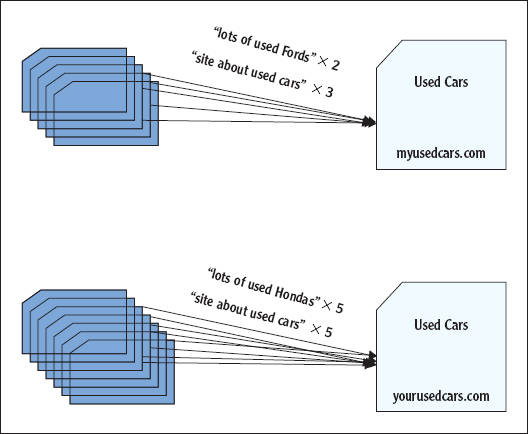THE INTRODUCTION OF PAGERANK
Google’s PageRank algorithm in 1998 was a big step forward in automatically cataloging and ranking websites.1 This algorithm used data from the links on the Web to determine what pages were about and which pages were more popular and useful. Links were like votes for a site, and the text from those links was used for cataloging them.
For instance, consider two web pages. One is at the address www.myusedcars.com, and the other is at the address www.yourusedcars.com. Both contain text about cars and have the title “Used Cars.” Five websites link to www.myusedcars.com. Three use the text “site about used cars,” and two use the text “lots of used Fords” in the links. Ten sites link to www.yourusedcars.com. Five use the text “site about used cars,” and the other five use the text “lots of used Hondas” in the links (Figure 5.1).
Figure 5.1 Anchor Text and Links Help Search Engines Understand Pages

Google’s PageRank algorithm would use the information from the links to determine that both sites were about used cars. But when someone searched for “used cars,” Google might show www.yourusedcars.com first because it had twice as many links to it (10 versus 5). In addition, when someone searched for “used Fords,” Google might show www.myusedcars.com, and when someone searched for “used Hondas, “Google might show www.yourusedcars.com.
Although Google patented ...
Get Marketing in the Age of Google: Your Online Strategy IS Your Business Strategy, Revised and Updated now with the O’Reilly learning platform.
O’Reilly members experience books, live events, courses curated by job role, and more from O’Reilly and nearly 200 top publishers.

